
Search Wild Foods Home Garden & Nature's Restaurant Websites:
Stinging Nettle
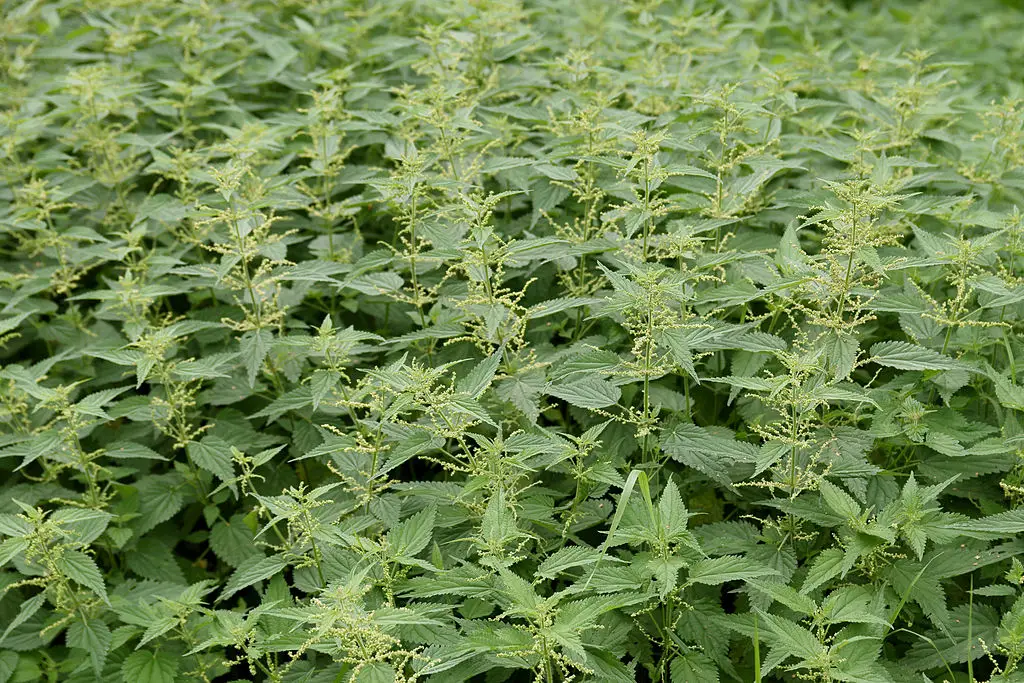
A beautiful crop of Stinging Nettles. (By: kallerna GNU Free Documentation License, Version 1.2)
(NOTE: If you are not interested in growing Stinging Nettles, but just finding the plant and using it, try going to the Nature's Restaurant Online site Stinging Nettle page.)
Top leaves picked from the Stinging Nettle (Urtica dioica) early in the season are my absolute favorite cooked green. I have never tasted a cooked green – either wild or domestic – that I like better.
If you don't have children or pets in the yard, this is a great plant to have for greens in the spring. Once you get it established in a spot, it just produces year after year. Nice looking plant as well - but stingy. If you do have children and/or pets and you still want to grow it, I strongly suggest growing it in a fenced in area. For myself, I find I need at least six perennial clumps (individual plants) per person. You can only take a few leaves on each one at a time, and unless you have a few, you won't get a lot. The season is very short, so you need a few plants to make up for that.
There is one odd, counter intuitive aspect to these greens: the greens from new, or first year plants don't taste very good. It is only early-in-the-season greens from established plants that are good to eat. In fact, over the years, I have experimented with this and have found the older and bigger the clump of Stinging Nettles, the better the greens taste. So knowing this, don't even bother eating the greens from them the first year they come up if you do plant by seed. If you want to be able to eat the greens from these in your garden the first year after you start growing them, you really do need to transplant a well established plant.
Is the growing of this plant compatible with Natural farming, Ecoagriculture or Eco friendly agriculture, Ecological farming, Sustainable agriculture, Agroforestry or Agro-sylviculture and Permaculture: This long lived perenial root system is ideal for Natural farming or no-till garden methods. Once you get these plants established, there is no need to ever till the soil around them.
Seeds: You can gather the tiny green/brown seeds from one in early fall just by tilting over a seed head on the plant into a jar or bag and rubbing it - there are no stingers on the ripe seed heads. You should get a lot of seeds quickly. They will turn brown when ready to harvest the seeds, usually mid September to mid October. Once you have the seeds, just spread them in the area you want the nettles right after getting home with them, and lightly rake into the soil and tamp down gently, and put on a thin leaf mulch. That's it – you will have some in the spring. The leaves and tops from the first year plants are not as good as from mature rootstock, so I'd pass on eating the leaves until the second year, and even those are not as good as from a plant that is many years old. If planted in a spot it likes, each clump of it will grow more stems each year.
Transplanting: The best way to get these is by transplanting. Even if you transplant just one, you can get seeds from it next season and start many more. In the fall, cut back all but the top 6 to 10 inches of growth, dig it up with plenty of soil, put in a plastic bag or bucket, and transplant to where you want it. This is best done in late fall - mid October to mid November. If you do it this way, you will get a decent harvest the next spring from each one you plant. Because of this, whenever I have moved, I always hunt around for mature specimens to take home and plant. There is variation in taste from different plants, so the first time you find one, take home some of the upper leaves, cook and see if they taste good. If so, wait until that fall to adopt it and make it part of your home garden family.
Soil & Site: From my experience, the taste varies with location and time of year. It seems the dryer the spot in the spring they are growing in and/or the later in the season, the poorer the taste. The tastiest seem to grow in damp, rich soils by river banks as soon as you can get them. What this translates to, is that if you want to grow really tasty Stinging Nettle greens, you need to find or make a location that is damp in the spring where the soil is very rich.
This plant will grow in full sun and partial shade. The soil should open, organically rich and loamy. It does well in low areas. It can grow in a wide range of soil pH - from 5.0 to 8.0, so rarely that is a problem. This is a plant that responds very well to nitrogen and overall nutrient levels in the soil. The best thing you can do for it is dig in a layer of composted manure into the soil where you are going to seed or transplant to. After the seedlings are up a little or after you transplant, mulch around the area well.
If you do live in an area with acidic soils, such as with conifer trees all around or blueberries growing in the area, the solution is quite simple. You can either add some lime to the top of the soil each year before adding the mulch and manure/compost, or if you heat with wood, spread the wood ash around on the ground in the area where they grow in the winter when you empty your stove. I did that, and do they ever like it. Don't over do it, but they can handle more alkaline (opposite of acidic) conditions than most plants and there is little that is more alkaline than wood ash. The combination of wood ash and manure where they grow will make them grow so thick and tall you won't beleive it!
Maintenance: Make sure the soil stays damp in the spring, up to when you are finished harvesting. After that, it should be fine on its own. After the harvest season, you don't have to do any maintenance, but you can do a couple of things. After the harvesting is over, you can cut back the plant by taking off about one third of the stalks with a pair of hedge clippers. Just leave the cut off sections on the ground around them. This keeps the plants shorter, which means they are less likely to topple over later in the year - they can get very tall if left. The other thing you can do, is cut off the flower/seed heads as they form. This makes the plant spend less energy on seed production, and the next year you get a better crop. Once the leaves start to yellow in the fall, you can use the pair of hedge clippers to cut them back to about 10 cm (4 inches) high, leaving the stalks on the ground and cover with a layer of composted manure, compost and/or mulch. All this organic material helps keep the soil damper in the spring, and you will notice each perennial clump will get bigger and bushier each year. As mentioned above, the combination of wood ash (if you can get it) and manure makes them grow so thick and tall it is amazing. This plant will reward your love with more and better tasting greens. They really show their appreciation for good treatment.
Harvesting: As soon as they are about 30 cm (1 foot) tall, begin harvesting the top 7.5 cm (3 inches) of greens. At this stage both the leaves and stems are tender and edible. May/June is usually about the only time they are worth eating. Even the new growth later in June just does not taste right, and can be stringy.
How to pick them: One way is to use gloves and a bag. They just snap off. If you see the tiny flowers forming, you are too late for this year. There is a bare handed technique for picking them. The stingers face slightly upwards, so move upwards with your thumb and forefinger as you are about to grab the stem. If you do it right, you will bend off the stinging hairs as you are grabbing without getting stung – in theory (laughing). But seriously, be prepared to get stung unless you have the skill of a surgeon no matter how you do it. Don't worry about the stings unless you are one of the people allergic to bee stings. If you are, don't grow these plants. If you are older and have arthritis, the stings are good for you, and you will notice you feel better for a couple of days after getting a few stings. I have a bad knee, and all season long, once per week I take a stalk from one of these and whack it against my knee on all sides until I've used up all the stingers. Makes a big difference for days. By the way, each stinger is actually a natural hypodermic needle, and what it injects is anti-inflammatory (unless you are allergic to bee stings).
Using: The leaves must be cooked to destroy the stingers, but after that it is up to you. They can be used in soups, baked dishes, anything. The way I like them best is a big plate of them lightly steamed and served with olive oil, lemon juice and a pinch of salt.
Stinging Nettles are full of nutrients. I wish I could remember where I read this, but one writer said that if they did not sting they would have gone extinct long ago, as they are so good tasting, and so rich in nutrients, that animals would have grazed them to oblivion.
Description:
- USDA Plant Hardiness Zone: 3-10 (More information on hardiness zones).
- Soil pH: 5.5-7.5
- Plant Size: 1 to over 2 meters (3 to 7 feet)
- Duration: Perennial (above ground part of plant dies back each winter to sprout again in spring from same root)
- Leaf Shape: Ovate coming to pointed tip, often but not always heart-shaped at base.
- Leaf Phyllotaxis (Arrangement) on branch: Decussate (Alternating Opposites. That is, they come in Opposite pairs that Alternate on the stem - if looking at the plant from above, you will have one pair at three and nine o'clock, then the next pair at twelve and six o'clock.)
- Leaf Size: 3-15 cm (1 to 6 inches) long
- Leaf Margin: Serrated (Sawtooth)
- Flowers: Very small green flowers on long (5-7.5 cm or 2 to 3 inches) thin clusters that come from the stalk of the plant where the leaf stems come out.
- Fruit: Very tiny reddish tan to black seeds
- Stem: Green, 4 sided, covered with small hollow hairs that are actually little hypodermic needles that inject the stinger chemicals - how amazing is that?
- Habitat: It likes rich, moist soil in full sun or partial shade. Often near rivers and creeks. Very often found where there was farming but now abandoned. I seem to find the healthiest ones in rich soil by rivers and creeks where it floods occasionally in the spring for short periods, and stays damp the rest of the season. Can be found as a clump here and there, or filling large areas. I find they often sprout from bags of purchased potting soil.
Web Resources:
- Recipe search on the web here (Google search) and here (Bing search).
- Pictures on the web here (Google images) and here (Bing images).
- Interactive USDA distribution map and plant profile here.
- The Biota of North America Program (BONAP) distribution map here. BONAP map color key here.
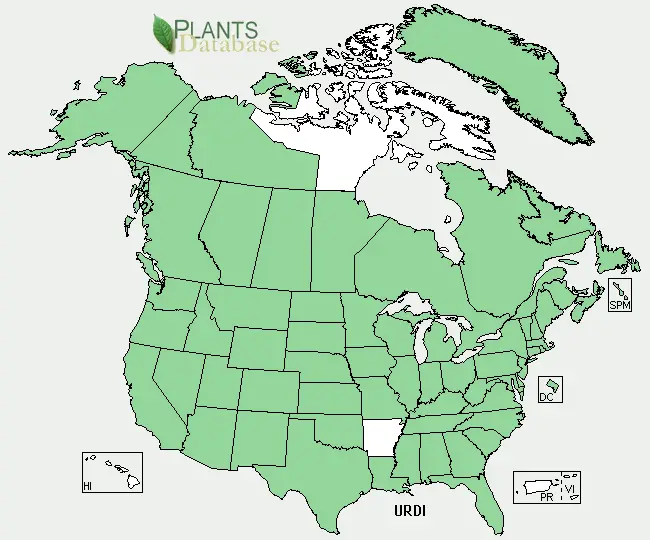
Stinging Nettle (Urtica dioica) range. Distribution map courtesy of U. S. Department of Agriculture (USDA Natural Resources Service) and used in accordance with their policies.
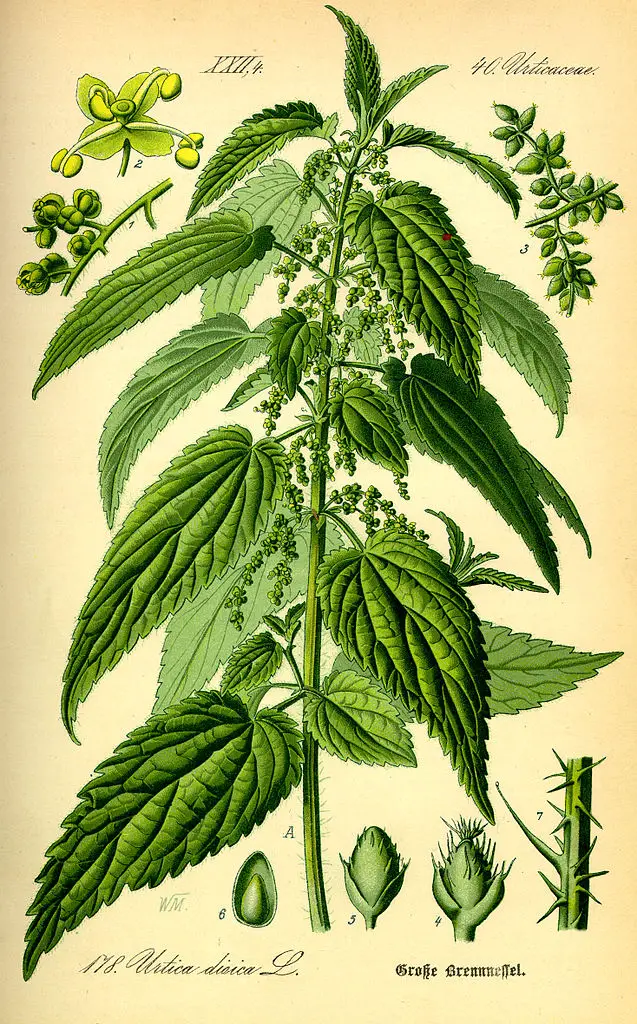
Stinging Nettle (Urtica dioica) illustration. (By: Prof. Dr. Otto Wilhelm Thomé Flora von Deutschland, Österreich und der Schweiz 1885, Gera, Germany)
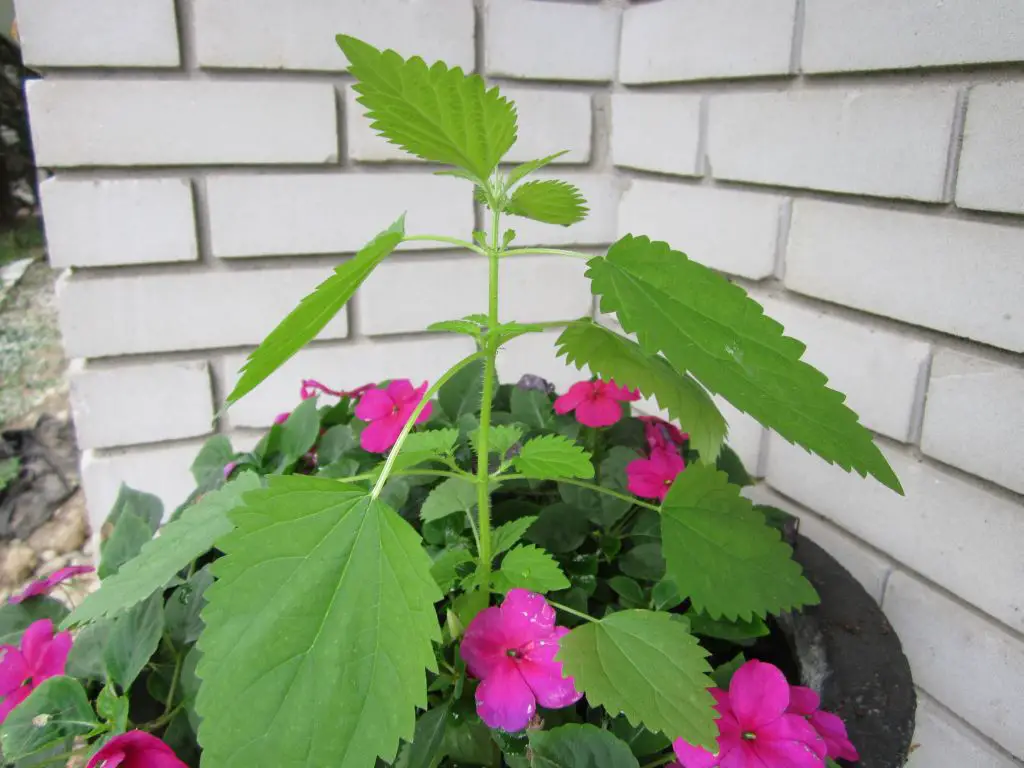
Young Stinging Nettle growing in with pink Impatiens in flower.
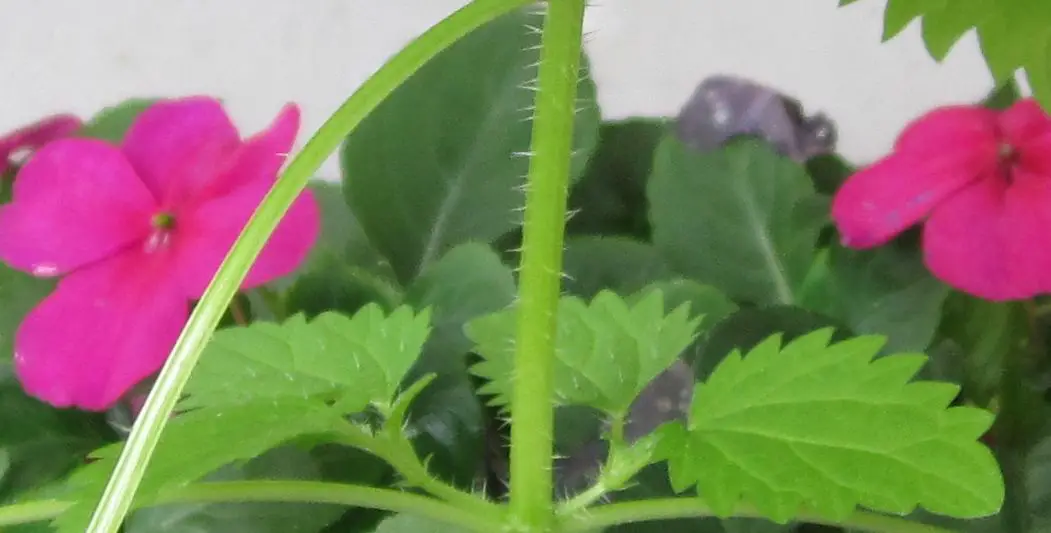
Close up of Stinging Nettle stem with stinging hairs visible. Impatiens flowers behind. I find it common for Stinging Nettles to come up in bagged potting soil – this is the case here. First year ones like this are not as good as the tops from mature rootstock.
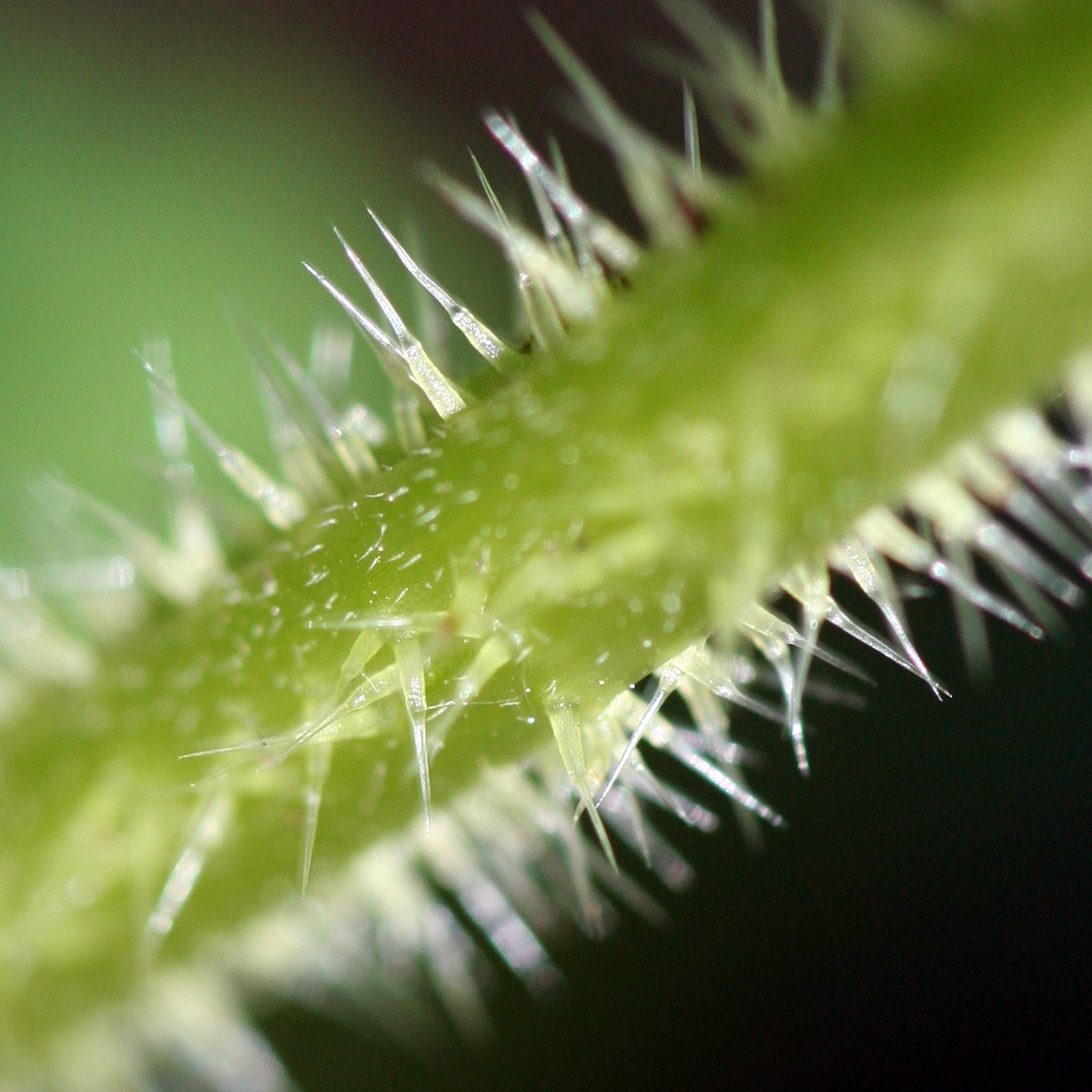
The stingers that defend the plant. These are basically biological hypodermic needles. (By: Randy A. Nonenmacher CC BY-SA 3.0)
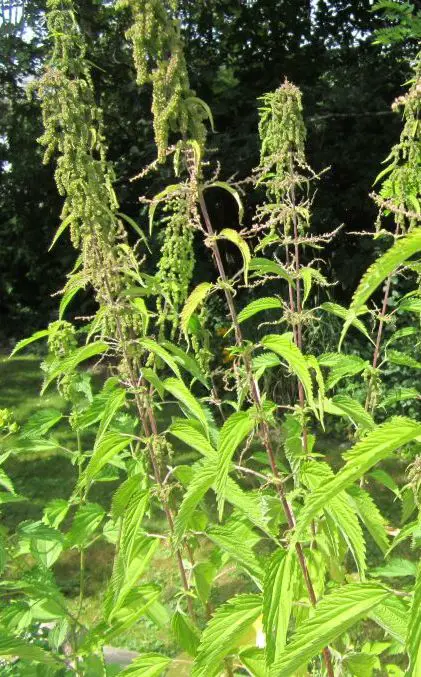
Stinging Nettle in seed in my garden. This picture was taken in late summer. Far too late for gathering leaves for food, but if you find some like this make note of the location, as there will be lots for picking next spring. If you want to grow some, these seed heads will provide hundreds of seeds.
Search Wild Foods Home Garden & Nature's Restaurant Websites:
Share:
Why does this site have ads?
Originally the content in this site was a book that was sold through Amazon worldwide. However, I wanted the information to available to everyone free of charge, so I made this website. The ads on the site help cover the cost of maintaining the site and keeping it available.
Google + profile
